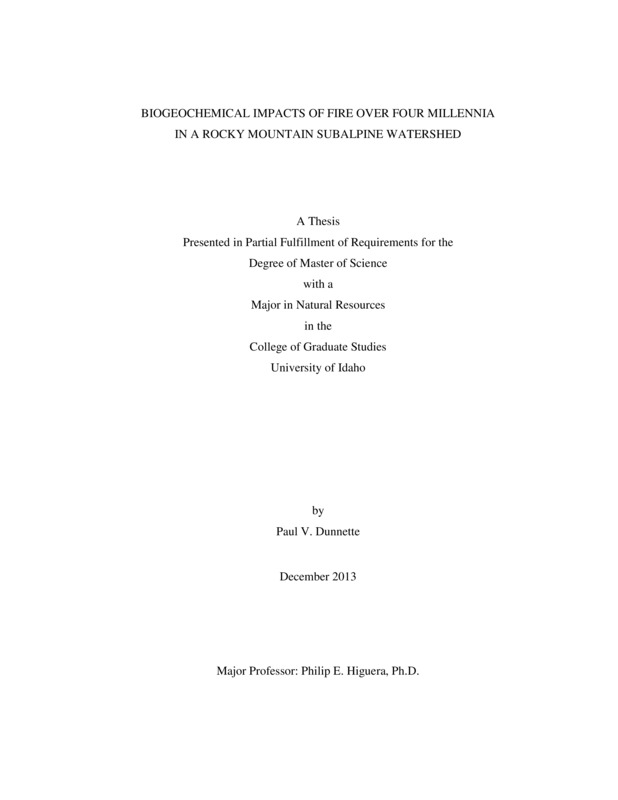Biogeochemical Impacts of Fire Over Four Millennia in a Rocky Mountain Subalpine Watershed
Dunnette, Paul Vincent. (2013). Biogeochemical Impacts of Fire Over Four Millennia in a Rocky Mountain Subalpine Watershed. Theses and Dissertations Collection, University of Idaho Library Digital Collections. https://www.lib.uidaho.edu/digital/etd/items/dunnette_idaho_0089m_10090.html
- Title:
- Biogeochemical Impacts of Fire Over Four Millennia in a Rocky Mountain Subalpine Watershed
- Author:
- Dunnette, Paul Vincent
- Date:
- 2013
- Keywords:
- Biogeochemistry Fire Forest Nitrogen Paleoecology Subalpine
- Program:
- Natural Resources
- Subject Category:
- Ecology; Environmental science
- Abstract:
-
Wildfires have the potential to dramatically alter forest carbon (C) storage and nitrogen (N) availability, but the long-term biogeochemical legacy of these events is poorly understood. I used a high-resolution lake-sediment record of fire occurrence and biogeochemical change from a subalpine watershed in Colorado, USA, to examine the nature, magnitude, and duration of fire-induced ecosystem impacts over the last ca. 4250 yr. Superposed Epoch Analysis (SEA) revealed pronounced biogeochemical responses to multiple high-severity fires, inferred from statistically significant peaks in charcoal accumulation and magnetic susceptibility (an indicator of erosion). On average, fires were followed closely by significant increases in bulk sediment N isotopic composition (d15N) and bulk density, and declines in %C and %N - likely reflecting destruction of the forest floor, terrestrial C and N losses, and erosion. Anomalously low sediment C:N ca. 20-50 yr after fires suggests a long-lived reduction in terrestrial organic matter subsidies to the lake. The magnitude of post-fire change was well-correlated with charcoal peak magnitude, indicating that the extent of disturbance impacts scaled directly with inferred fire size and/or severity. Trends ca. 30-75 yr following fire, including a significant decline in d15N, were consistent with patterns observed in chronosequences of forest C and N accumulation, suggesting that terrestrial successional processes were reflected in the sediments. The results of this study, the first to systematically test the utility of lake-sediment d15N as an indicator of fire-induced N cycle change, indicate that high-resolution analysis of sediment records may offer a unique and powerful tool for elucidating the effects of fire on ecosystem biogeochemistry over decades to millennia.
- Description:
- masters, M.S., Natural Resources -- University of Idaho - College of Graduate Studies, 2013
- Major Professor:
- Higuera, Philip E
- Committee:
- Kavanagh, Kathleen L; Marshall, John D; McLauchlan, Kendra K; Wilhelm, Frank M
- Defense Date:
- 2013
- Identifier:
- Dunnette_idaho_0089M_10090
- Type:
- Text
- Format Original:
- Format:
- application/pdf
- Rights:
- In Copyright - Educational Use Permitted. For more information, please contact University of Idaho Library Special Collections and Archives Department at libspec@uidaho.edu.
- Standardized Rights:
- http://rightsstatements.org/vocab/InC-EDU/1.0/

